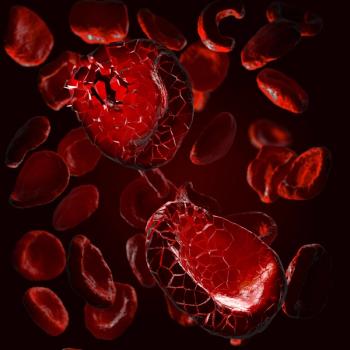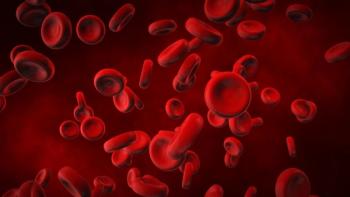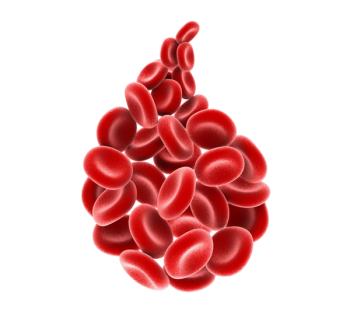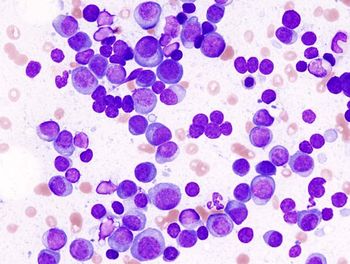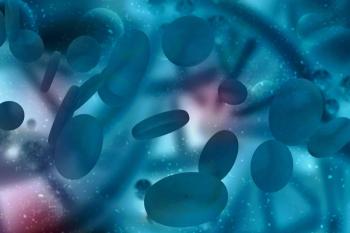
Bemarituzumab Regimen Prolongs Survival in Advanced Gastric/GEJ Cancer
The overall survival benefit with the bemarituzumab combination in the phase 3 FORTITUDE-101 trial was consistent across key prespecified subgroups.
Data from the phase 3 FORTITUDE-101 trial (NCT05052801) showed an overall survival (OS) improvement with bemarituzumab plus modified oxaliplatin, leucovorin, and fluorouracil (mFOLFOX6) vs placebo plus mFOLFOX6 among those with advanced or metastatic, FGFR2b-overexpressing gastric or gastroesophageal junction (GEJ) cancer, according to a presentation at the
At a median follow-up of 11.8 months and a data cutoff date of December 9, 2024, among patients with FGFR2b overexpression on at least 10% of tumor cells, the median OS was 17.9 months (95% CI, 13.0-20.8) among patients who received bemarituzumab plus mFOLFOX6 (n = 159) vs 12.5 months (95% CI, 10.5-14.7) among those who received placebo plus mFOLFOX6 (n = 165; HR, 0.61; 95% CI, 0.43-0.86; 2-sided P = .005). This OS benefit with bemarituzumab was consistent across key prespecified subgroups.
However, presenting author Sun Young Rha, MD, PhD , noted that the trial investigators “observed OS benefit attenuation at a subsequent descriptive follow-up analysis.”
At a median follow-up of 19.4 months and a data cutoff date of June 20, 2025, among patients with FGFR2b overexpression on at least 10% of tumor cells, the median OS was 14.5 months (95% CI, 13.0-17.9) among patients in the bemarituzumab arm vs 13.2 months (95% CI, 10.9-14.7) among those in the placebo arm (HR, 0.82; 95% CI, 0.62-1.08).
Rha is a professor of medical oncology in the Department of Internal Medicine and the director of the Songdang Institute for Cancer Research at the Yonsei University College of Medicine, part of the Yonsei University Health Systemin in Korea.
What background information supported the rationale for the FORTITUDE-101 trial?
Bemarituzumab targets FGFR2b, which is overexpressed in advanced gastric/GEJ cancers. Previously, the phase 2 FIGHT trial (NCT03694522) showed that bemarituzumab plus mFOLFOX6 elicited a numerically longer median progression-free survival (PFS) and OS vs placebo plus mFOLFOX6 in patients with FGFR2b-overexpressing, non-HER2–mutated, advanced gastric/GEJ cancers.2
What was the design of the FORTITUDE-101 trial?
This global, randomized, double blind FORTITUDE-101 trial initially enrolled patients with locally unresectable or metastatic gastric/GEJ cancer with FGFR2b overexpression of 2+ or 3+ at any percentage of tumor cells by central immunohistochemistry.1 This criterion was later amended to limit the population to patients with FGFR2b overexpression of 2+ or 3+ on at least 10% of tumor cells. Patients could not have received prior therapy for locally unresectable or metastatic disease, however, 1 prior cycle of mFOLFOX6 was allowed. Patients could not have known HER2-positive disease.
Patients were stratified by geography (United States/European Union vs Japan/South Korea vs rest of world), ECOG performance status (0 vs 1), and PD-L1 status (combined positive score [CPS] ≥ 5 vs CPS < 5 or indeterminate). Patients were randomly assigned 1:1 to receive bemarituzumab at 15 mg/kg every 2 weeks plus 7.5 mg/kg on cycle 1 day 8 plus mFOLFOX6 (FGFR2b ≥ 10% population, n = 159; safety analysis population, n = 275) or placebo plus mFOLFOX6 (FGFR2b ≥ 10% population, n = 165; safety analysis population, n = 267).
OS in the population of patients with FGFR2b expression of at least 10% served as the primary end point. Key secondary end points included PFS and overall response rate (ORR) in patients with FGFR2b expression of at least 10%, as well as safety in all randomly assigned patients.
What additional efficacy data were seen in FORTITUDE-101?
Rha explained that the patient baseline characteristics were well balanced between the 2 arms.
Further efficacy findings showed that the addition of bemarituzumab to mFOLFOX6 significantly improved PFS but not ORR. Among patients with FGFR2b overexpression in at least 10% of tumor cells, at a median follow-up of 11.1 months, the median PFS was 8.6 months (95% CI, 7.5-9.5) in the bemarituzumab arm vs 6.7 months (95% CI, 5.6-7.6) in the placebo arm (HR, 0.71; 95% CI, 0.53-0.95; 2-sided P = .019). The ORRs in these respective arms were 45.9% (95% CI, 38.0%-54.0%) and 44.8% (95% CI, 37.1%-52.8%; 2-sided P = .90). The median DORs in these respective arms were 7.0 months (95% CI, 5.3-7.3) and 5.8 months (95% CI, 5.0-7.3).
What was the safety profile of bemarituzumab in FORTITUDE-101?
At the June 20, 2025, cutoff date, the median duration of bemarituzumab treatment in the safety analysis set was 22 weeks (range, < 1-136), and the median duration of placebo was 25 weeks (range, < 1-154). The median durations of mFOLFOX6 treatment in these respective arms were 25 weeks (range, < 1-148) and 23 weeks (range, < 1-154).
Treatment-emergent adverse effects (TEAEs) in the bemarituzumab and placebo arms, respectively, were classified as:
- Any grade (> 99% vs 98%)
- Grade 3 or higher (90% vs 79%)
- Leading to treatment interruption (68% vs 40%)
- Leading to treatment withdrawal (28% vs 6%)
Treatment-related AEs in the bemarituzumab and placebo arms, respectively, were classified as:
- Any grade (> 89% vs 66%)
- Grade 3 or higher (60% vs 18%)
- Leading to treatment interruption (52% vs 12%)
- Leading to treatment withdrawal (24% vs 1%)
- Fatal (0% vs < 1%)
The most common any-grade TEAEs (≥ 25% of patients) seen with bemarituzumab included reduced visual acuity, punctuate keratitis, anemia, neutropenia, nausea, corneal epithelial defect, and dry eye. The most common grade 3 or higher TEAEs were reduced visual acuity (bemarituzumab arm, 33%; placebo arm, 0%); corneal events, including punctuate keratitis (26%; < 1%), corneal epithelium defect (14%; 0%), limbal stem cell deficiency (14%; < 1%), ulcerative keratitis (8%; 0%); and non-corneal events, including neutropenia (31%; 30%), decreased neutrophil count (9%; 9%), anemia (9%; 11%), stomatitis (7%; 1%), and fatigue (5%; 3%).
Notably, among patients who received bemarituzumab and had at least 17 weeks of ocular follow-up, 90% of grade 3 or higher corneal AEs resolved to grade 1 or lower. Corneal AEs had delayed onset and gradual resolution; however, resolution of visual acuity happened quicker. The median time to onset of grade 3 or higher corneal AEs was 24 weeks, and the median time to resolution was 17 weeks, with a 70% resolution rate. The median time to onset of visual acuity reduction was also 24 weeks; however, the median time to resolution was 8 weeks, and the resolution rate was 83%.
“Results from this trial and the upcoming [phase 3] FORTITUDE-102 study [NCT05111626] will further characterize the benefit-risk profile of bemarituzumab in FGFR2b-positive gastric cancer,” Rha concluded.
FORTITUDE-102 is investigating bemarituzumab plus mFOLFOX6 or CAPOX (capecitabine and oxaliplatin) and nivolumab (Opdivo) vs placebo plus mFOLFOX6 or CAPOX in patients with previously untreated advanced gastric/GEJ cancer with FGFR2b overexpression.3
Disclosures: Rha reported having consulting or advisory roles with Amgen, Arcus Biosciences, Astellas Pharma, AstraZeneca, BI, BeOne, Daiichi Sankyo, Indivumed, Jazz, LG Chem, MSD Oncology, Ono, and Toray; participating in speaker’s bureaus for Amgen, Arcus Biosciences, Astellas Pharma, AstraZeneca, BMS/Ono, Daiichi Sankyo, Eisai, and MSD Oncology; and receiving research funding from with Amgen, Astellas Pharma, AstraZeneca, Bayer, BeOne, BI, Bristol-Myers Squibb, Daiichi Sankyo, Eisai, Indivumed, Eli Lilly, Jazz, MSD Oncology, Roche/Genentech, Sillajen, and Taiho.
References
- Rha SY, Cid RP, Montes AF, et al. Bemarituzumab (BEMA) plus chemotherapy for advanced or metastatic FGFR2b-overexpressing gastric or gastroesophageal junction cancer (G/GEJC): FORTITUDE-101 phase 3 study results. Presented at: 2025 ESMO Congress. October 17-21, 2025; Berlin, Germany. Abstract LBA10.
- Wainberg ZA, Kang YK, Lee KW, et al. Bemarituzumab as first-line treatment for locally advanced or metastatic gastric/gastroesophageal junction adenocarcinoma: final analysis of the randomized phase 2 FIGHT trial. Gastric Cancer. 2024;27(3):558-570. doi:10.1007/s10120-024-01466-w
- Bemarituzumab plus chemotherapy and nivolumab versus chemotherapy and nivolumab for FGFR2b overexpressed untreated advanced gastric and gastroesophageal junction cancer. (FORTITUDE-102). ClinicalTrials.gov. Updated Oc
Newsletter
Stay up to date on recent advances in the multidisciplinary approach to cancer.


